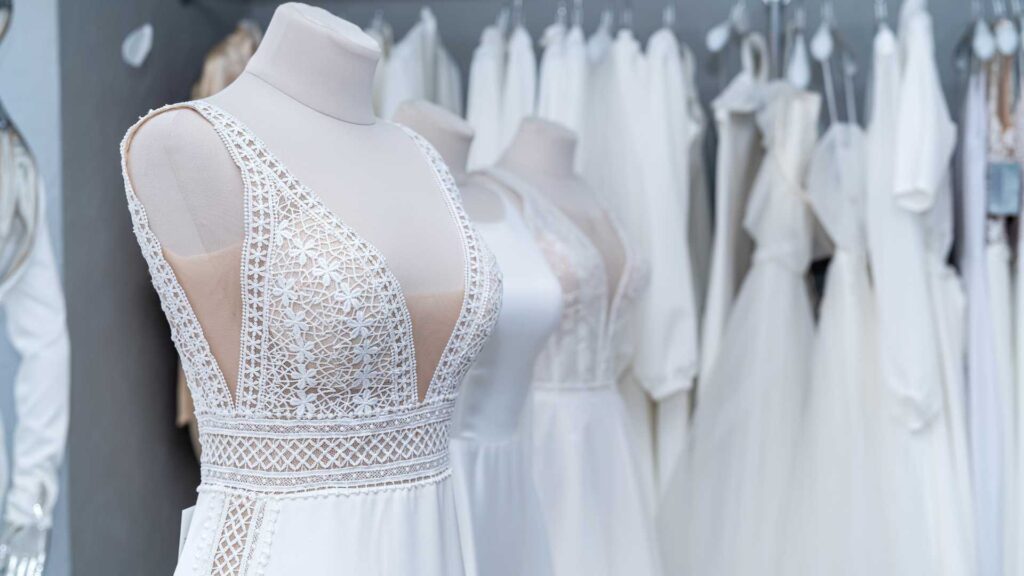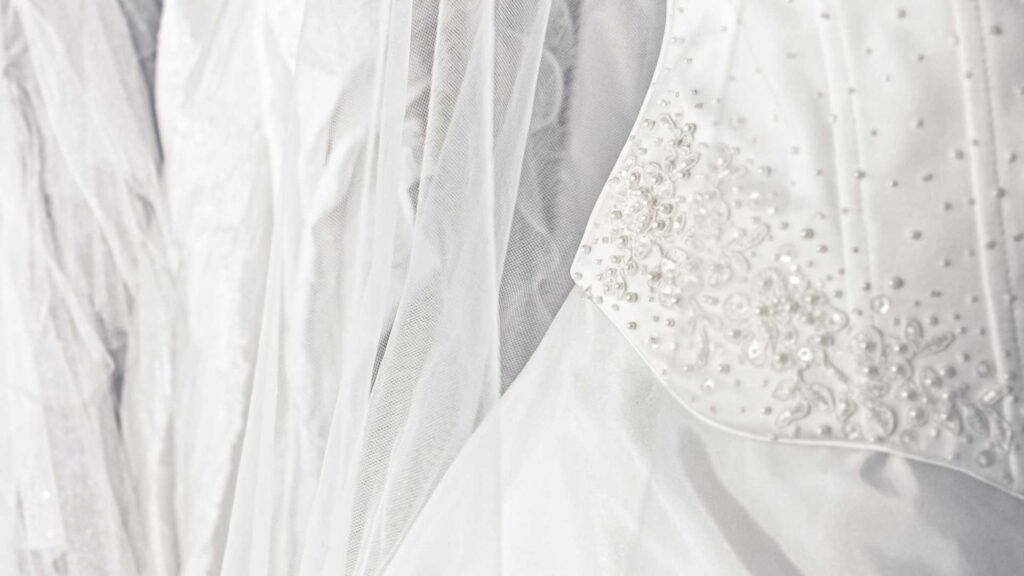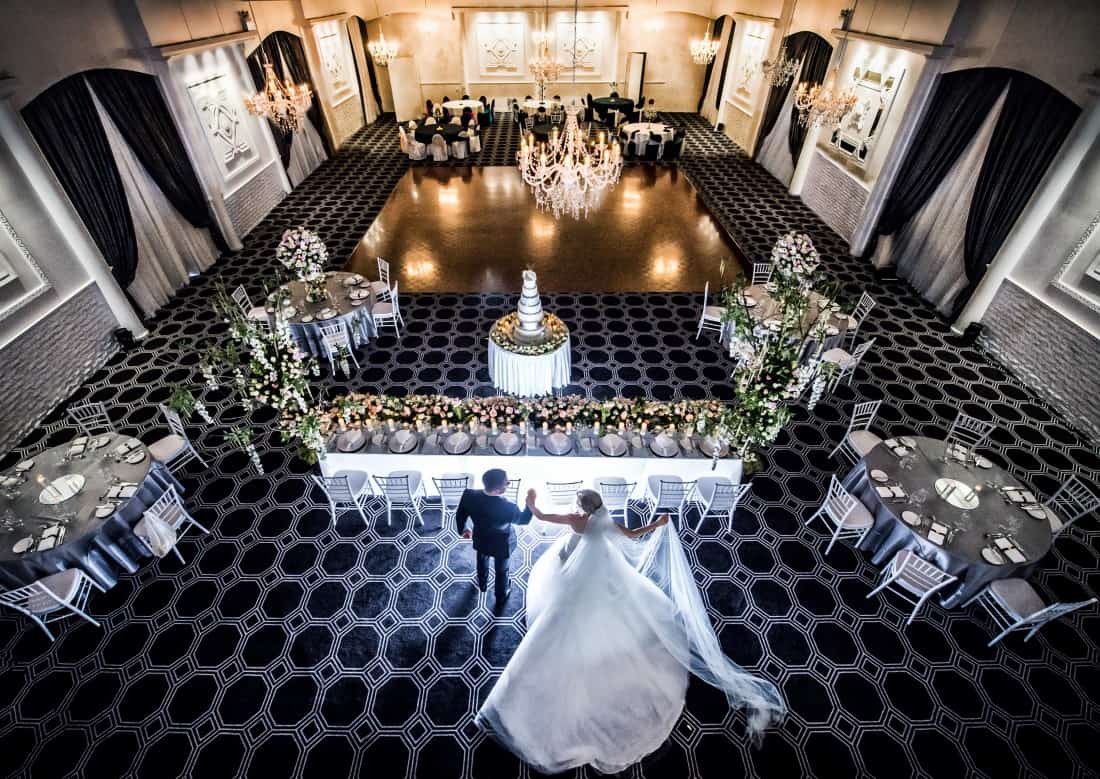Preserving your wedding dress often becomes a top priority after your wedding day. Brides may wonder if vacuum sealing is a good option for long-term storage. While it might seem practical, there are several important factors to consider regarding vacuum bags. Let’s look at the potential risks, alternatives, and best practices for preserving wedding dresses.
Let’s Get Straight to the Point
Storing your wedding dress in a vacuum bag is not recommended due to risks like trapped moisture, fabric distortion, and exposure to harmful plastic fumes. These conditions can lead to permanent damage, such as mould growth, creasing, and yellowing.
Instead, safer alternatives include professional preservation services that clean and store the dress in acid-free boxes or tissue paper, ensuring protection from environmental damage. Other methods, such as the boxing method (using breathable, acid-free boxes) and bagging method (hanging the dress in breathable garment bags), are also effective.
For a DIY approach, use acid-free materials and store the dress in a cool, dry place. Avoid plastic bags and check the dress periodically to maintain its condition. Proper storage is crucial to preserving the delicate fabrics of a wedding dress.
The Risks Of Storing A Wedding Dress In A Vacuum Bag
Although vacuum bags can save space, storing your wedding dress in one presents some significant risks, including:
- Trapped Moisture: Even in low-humidity environments, a small amount of moisture can be sealed inside a vacuum bag. This trapped moisture creates a perfect environment for mould and mildew to grow, potentially ruining the dress fabric.
- Fabric Distortion: The compression from vacuum sealing can flatten or distort delicate fabrics like lace, silk, and tulle. These materials are highly susceptible to permanent creases, which can become difficult, if not impossible, to remove.
- Exposure to Plastic Fumes: Over time, vacuum bags from certain plastics can degrade, releasing harmful chemicals. These fumes may cause yellowing or other fabric damage, compromising the dress’s appearance.
Due to these risks, storing a wedding dress in a vacuum-sealed bag is generally not recommended. The convenience of space-saving doesn’t outweigh the potential for permanent damage to your cherished gown.
Alternatives To Vacuum Storage For Wedding Dresses
When storing your wedding dress, vacuum sealing can seem like a practical solution, but it carries significant risks. Fortunately, there are safer and more effective alternatives for long-term storage that ensure your dress remains in pristine condition. Let’s explore these options in detail:
1. Professional Wedding Dress Preservation Services
A professional preservation service is one of the most reliable ways to ensure your wedding dress stays in excellent condition. These services are done by experts specialising in cleaning, preserving, and packaging delicate garments like wedding dresses. While the cost can be high, the investment is worthwhile considering the risks of damage from improper storage.
Here’s what to expect with professional preservation:
- Thorough Cleaning: Before the dress is preserved, it will be professionally cleaned to remove stains, dirt, body oils, and invisible residues such as makeup or perfume. This step is important in preventing long-term damage, as even small stains can oxidise and turn yellow over time.
- Repairs and Restoration: Some preservation services also offer minor repairs, such as mending loose beading, stitching tears, or restoring delicate lace, ensuring the dress is returned to its original condition.
- Acid-Free Packaging: The dress is then stored in acid-free tissue paper and placed in an acid-free box. Acid-free materials are essential because they prevent discolouration and deterioration of the fabric. The absence of acids in the materials reduces the risk of fabric weakening or yellowing, which can happen over time with regular storage materials.
2. Boxing Method
The boxing method involves placing the dress in a breathable box made from acid-free materials. Here’s how it works:
- Folding with Acid-Free Tissue: The dress is carefully folded, with acid-free tissue paper placed between the folds to prevent creases from becoming permanent. The tissue also helps to cushion delicate areas such as the bodice, sleeves, and embellishments.
- Breathable Protection: Unlike vacuum-sealed bags, the box allows the fabric to breathe. This helps regulate humidity levels and prevents moisture from becoming trapped, which can lead to mould and mildew growth.
- Long-Term Accessibility: The boxing method also allows you to check on your dress periodically without disrupting the preservation process. You can refold the dress every few years to avoid permanent creases and ensure it remains in optimal condition.
3. Bagging Method
Another popular option for preserving wedding dresses is bagging. This method involves storing the dress in a garment bag designed for long-term storage, such as those used by museums for heirloom textiles.
- Hanging the Dress: The dress is hung on a padded hanger to reduce stress on the fabric and prevent stretching or distortion. Twill tape or similar materials are sometimes used to support heavier areas of the gown.
- Breathable Garment Bag: A breathable garment bag, typically made from muslin or cotton, allows air to circulate the dress while protecting it from dust, dirt, and light. Unlike plastic bags, these bags do not trap moisture, making them ideal for long-term storage.
- Avoiding Creases: Since the dress is hung and not folded, this method is especially useful for gowns of fabrics prone to creasing, like silk or satin.
4. DIY Preservation With Acid-Free Materials
Using acid-free materials is key for brides who prefer a more cost-effective approach and want to handle the preservation process themselves. Here’s a step-by-step guide for a DIY preservation process:
- Purchase Acid-Free Materials: Obtain acid-free tissue paper and an acid-free storage box for wedding dress storage.
- Clean the Dress: As with professional services, make sure your dress is thoroughly cleaned before storing it if you don’t opt for professional cleaning, carefully hand wash or spot-clean any stains or marks.
- Folding the Dress: Place tissue paper between the layers of fabric to cushion delicate areas and prevent permanent creases. Please pay special attention to the bodice, sleeves, and any embellishments, stuffing them with tissue paper for added protection.
- Store in a Cool, Dry Place: Store the acid-free box in a cool, dark, and dry area, such as a closet. Avoid places like attics, basements, or anywhere with extreme temperature changes, which could lead to moisture buildup or fabric deterioration.
Best Practices For Storing A Wedding Dress
To ensure your wedding dress remains as beautiful as the day you wore it, follow these best practices for storage:
- Store in a Cool, Dry Place: Keep the dress in an area that doesn’t experience extreme temperature or humidity fluctuations. Avoid attics, basements, or garages where heat, cold, and moisture can cause damage.
- Use Acid-Free Materials: Wrap the dress in acid-free tissue paper and store it in a breathable, acid-free box. Acid-free materials prevent the breakdown of delicate fabrics, preserving their colour and integrity.
- Avoid Plastic Bags: Regular plastic bags can trap moisture and release harmful chemicals as they degrade. Instead, use breathable garment bags for short-term storage and acid-free boxes for long-term storage.
- Check Periodically: Every few years, take the dress out of storage to inspect it. Refold it along different lines to prevent permanent creasing in one spot.
Why Storing A Wedding Dress Correctly Is Important
Wedding dresses are often made of delicate materials like silk, lace, and tulle, which are highly susceptible to environmental damage. Factors like humidity, mould, and even sunlight can cause irreversible damage. Proper storage is essential to maintain the gown’s beauty and prevent discolouration, fabric weakening, or deformation.
While vacuum bags might seem space-efficient, they pose several long-term risks that can damage your wedding dress. Instead, opt for professional preservation services or follow best practices that use acid-free materials and breathable storage solutions. Taking the right steps ensures your dress remains in perfect condition, preserving its beauty for generations.




